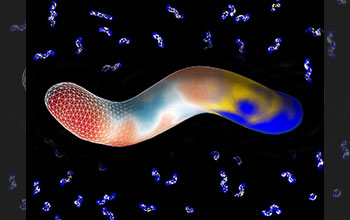Multimedia Gallery
An idealized H. pylori cell with transition from microscopy image
Researchers at the Fred Hutchinson Cancer Research Center have found that the bacterium Helicobacter pylori maintains its helical shape by targeting cell-wall synthesis to two areas with opposite curvature properties. To determine where H. pylori cells add new wall components, the researchers distinguished between areas of positive curvature. In this image, in the background are microscope images of H. pylori cells with new wall components glowing blue and a cell wall-directing protein in yellow. In the foreground is an idealized H. pylori cell showing the transition from the microscopy images (in blue and yellow on the right) to the curvature (in red and blue in the middle). The triangular meshwork on the left represents the mathematically idealized cell surface.
[Research supported by National Science Foundation grants DGE 0718124, DGE 1256082 and PHY 1734030.]
Learn more in the Fred Hutchinson Cancer Research Center news story How Helicobacter stays helical. (Date image taken: Dec. 16, 2019; date originally posted to NSF Multimedia Gallery: June 20, 2020)
Credit: Jennifer A. Taylor/Fred Hutchinson Cancer Research Center
Images and other media in the National Science Foundation Multimedia Gallery are available for use in print and electronic material by NSF employees, members of the media, university staff, teachers and the general public. All media in the gallery are intended for personal, educational and nonprofit/non-commercial use only.
Images credited to the National Science Foundation, a federal agency, are in the public domain. The images were created by employees of the United States Government as part of their official duties or prepared by contractors as "works for hire" for NSF. You may freely use NSF-credited images and, at your discretion, credit NSF with a "Courtesy: National Science Foundation" notation.
Additional information about general usage can be found in Conditions.
Also Available:
Download the high-resolution JPG version of the image. (895.0 KB)
Use your mouse to right-click (Mac users may need to Ctrl-click) the link above and choose the option that will save the file or target to your computer.

